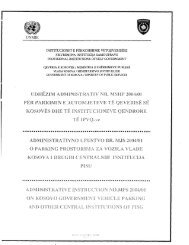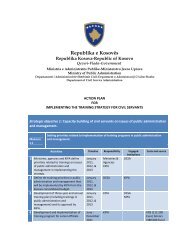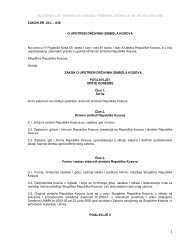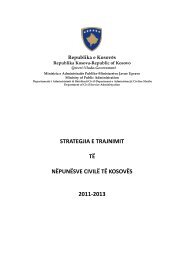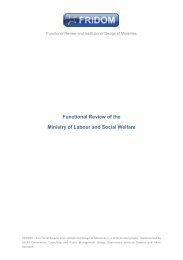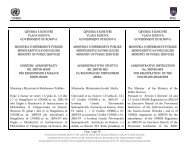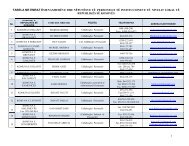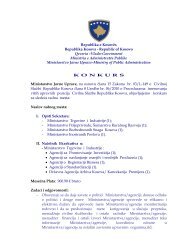Functional Review of the Ministry of Environment and Spatial Planning
Functional Review of the Ministry of Environment and Spatial Planning
Functional Review of the Ministry of Environment and Spatial Planning
Create successful ePaper yourself
Turn your PDF publications into a flip-book with our unique Google optimized e-Paper software.
<strong>the</strong>ir tasks <strong>and</strong> <strong>the</strong> importance <strong>of</strong> <strong>the</strong> activities performed predetermine that both CEOs report directly to <strong>the</strong><br />
Minister ra<strong>the</strong>r <strong>the</strong>n to <strong>the</strong> PS.<br />
Despite <strong>the</strong> absence <strong>of</strong> a unified approach elsewhere, we recommend that a common management /<br />
reporting line is defined for all MESP units. That means that <strong>the</strong> PS would have managerial responsibility<br />
for what we define as <strong>the</strong> central MESP. This would <strong>the</strong>n apply to all policy (formulation <strong>and</strong> monitoring)<br />
departments within <strong>the</strong> MESP portfolio.<br />
The policy implementation units (MESP agencies) can stay under direct control <strong>of</strong> <strong>the</strong> Minister with some<br />
sort <strong>of</strong> central MESP supervision <strong>of</strong> <strong>the</strong>ir performance necessary to allow policy feedback. We recommend<br />
that <strong>the</strong> supervision function <strong>of</strong> central MESP towards its agencies is streng<strong>the</strong>ned significantly. The<br />
agencies should remain independent in <strong>the</strong>ir operation; however <strong>the</strong> efficiency <strong>of</strong> policy execution should<br />
be monitored <strong>and</strong> evaluated closely by <strong>the</strong> central MESP.<br />
This is good for both <strong>the</strong> policy formulation feedback <strong>and</strong> managerial accountability <strong>of</strong> agency executive<br />
<strong>of</strong>ficers. This recommendation is in line with <strong>the</strong> Whole <strong>of</strong> Government <strong>Review</strong> <strong>and</strong> also applies to all o<strong>the</strong>r<br />
ministries. Implementation <strong>of</strong> this step helps to distinguish policy <strong>and</strong> legislation function undertaken by<br />
<strong>the</strong> departments <strong>and</strong> implementation <strong>and</strong> environmental monitoring activities what are in most cases<br />
realized by agencies <strong>and</strong> institutes under <strong>the</strong> MESP.<br />
Recommendation II.5: Adjust <strong>and</strong> unify <strong>the</strong> management / reporting lines. Define <strong>the</strong> subordination <strong>of</strong><br />
agencies <strong>and</strong> departments clearly <strong>and</strong> consistently.<br />
Substantially different is <strong>the</strong> position <strong>of</strong> <strong>the</strong> Institute for <strong>Spatial</strong> <strong>Planning</strong> (ISP) which we recommend<br />
remains under <strong>the</strong> direct supervision <strong>of</strong> <strong>the</strong> Department <strong>of</strong> <strong>Spatial</strong> <strong>Planning</strong> mostly because <strong>of</strong> its<br />
supportive function in <strong>the</strong> urban/spatial planning processes <strong>and</strong> its irredeemable position in <strong>the</strong> reviewing<br />
<strong>and</strong> monitoring <strong>of</strong> <strong>the</strong> documents <strong>of</strong> <strong>the</strong> spatial planning in <strong>the</strong> whole territory <strong>of</strong> Kosovo.<br />
It is worth noting that KEPA, KCA <strong>and</strong> ISP use fully compatible Geographic Information System (GIS)<br />
technology which allows <strong>the</strong> centralizing <strong>of</strong> all environmental <strong>and</strong> spatial data into one data warehouse.<br />
This centralization does not mean <strong>the</strong> automatic creation <strong>of</strong> a new unit or increasing <strong>the</strong> expenditure in<br />
hardware or s<strong>of</strong>tware - it simply gives an emphasis on <strong>the</strong> human capacity inside <strong>the</strong> KEPA. In <strong>the</strong><br />
medium-term it is possible to think about <strong>the</strong> creation <strong>of</strong> a fair base for <strong>the</strong> development <strong>of</strong> <strong>Environment</strong>al<br />
Monitoring System in whole Kosovo.<br />
Recommendation II.6: Create a central GIS coordination unit with <strong>the</strong> aim to develop <strong>the</strong> environmental<br />
monitoring system in whole Kosovo.<br />
A similar principle as for <strong>the</strong> agencies could be applied also for <strong>the</strong> Management <strong>of</strong> National Parks (NP)<br />
where <strong>the</strong> consultants’ proposal is to integrate it within <strong>the</strong> KEPA portfolio. At <strong>the</strong> time <strong>of</strong> <strong>the</strong> report writing<br />
<strong>the</strong>re was established in Kosovo only NP Mali Sharr <strong>and</strong> in <strong>the</strong> short term is envisaged to constitute <strong>the</strong><br />
NP Bjeshkët e Nemuna. This seems to be sufficient for <strong>the</strong> long term. Merging could bring a mutual<br />
benefit for <strong>the</strong> both - The Institute for Nature Protection, which creates an integral part <strong>of</strong> KEPA <strong>and</strong> <strong>the</strong><br />
Management <strong>of</strong> National Parks. Certain independence for <strong>the</strong> director <strong>of</strong> <strong>the</strong> NP can be ensured in <strong>the</strong><br />
case <strong>of</strong> managerial subordination <strong>and</strong> also with <strong>the</strong> distance <strong>of</strong> <strong>the</strong> NP headquarters location.<br />
It is necessary to mention that this entire merger should not be accompanied by a decrease in remuneration or<br />
<strong>the</strong> relative importance <strong>of</strong> managers <strong>and</strong> employees <strong>of</strong> <strong>the</strong> affected units.<br />
II.4 Strategic <strong>and</strong> policy planning<br />
It is repeatedly noted throughout <strong>the</strong> report that strategic <strong>and</strong> policy planning capacity in <strong>the</strong> <strong>Ministry</strong> is<br />
among <strong>the</strong> weakest although <strong>the</strong>y represent <strong>the</strong> most important core competencies <strong>of</strong> a government<br />
institution.<br />
Strategic planning at MESP (with some exceptions) is driven bottom-up, fragmented, <strong>and</strong> <strong>of</strong>ten formulated<br />
by foreign advisors instead <strong>of</strong> MESP managers. There is a procedure in place that governs <strong>the</strong> creation <strong>of</strong><br />
an annual activity plan for <strong>the</strong> MESP, <strong>and</strong> that is part <strong>of</strong> a government-wide effort to establish some sort <strong>of</strong><br />
strategic planning. Having a one-year focus, this plan cannot serve as a base for strategic decision<br />
making within <strong>the</strong> organization. Fur<strong>the</strong>rmore, plans are prepared at department level <strong>and</strong> <strong>the</strong>n compiled<br />
15



